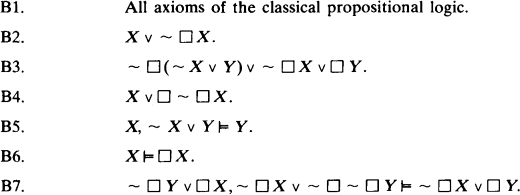Crossref Citations
This article has been cited by the following publications. This list is generated based on data provided by
Crossref.
Hardegree, Gary M.
1979.
The Logico-Algebraic Approach to Quantum Mechanics.
p.
49.
Marcus, Ruth Barcan
1981.
Tome 1 Philosophie du langage, Logique philosophique / Volume 1 Philosophy of language, Philosophical logic.
p.
279.
Svetlichny, George
1986.
Quantum supports and modal logic.
Foundations of Physics,
Vol. 16,
Issue. 12,
p.
1285.
Pavičić, Mladen
1989.
Unified quantum logic.
Foundations of Physics,
Vol. 19,
Issue. 8,
p.
999.
Pavičić, M.
1992.
A new axiomatization of unified quantum logic.
International Journal of Theoretical Physics,
Vol. 31,
Issue. 9,
p.
1753.
Pavičić, M.
1992.
Bibliography on quantum logics and related structures.
International Journal of Theoretical Physics,
Vol. 31,
Issue. 3,
p.
373.
Pavičić, M.
1993.
Nonordered quantum logic and its YES-NO representation.
International Journal of Theoretical Physics,
Vol. 32,
Issue. 9,
p.
1481.
Nishimura, Hirokazu
1994.
Proof theory for minimal quantum logic I.
International Journal of Theoretical Physics,
Vol. 33,
Issue. 1,
p.
103.
Rawling, J. P.
and
Selesnick, S. A.
2000.
Orthologic and quantum logic.
Journal of the ACM,
Vol. 47,
Issue. 4,
p.
721.
Kaniel, S.
and
Itin, Y.
2006.
Equations of motion for a (non‐linear) scalar field model as derived from the field equations.
Annalen der Physik,
Vol. 518,
Issue. 12,
p.
877.
Domenech, G.
Freytes, H.
and
de Ronde, C.
2006.
Scopes and limits of modality in quantum mechanics.
Annalen der Physik,
Vol. 518,
Issue. 12,
p.
853.
Domenech, Graciela
Freytes, Hector
and
de Ronde, Christian
2009.
Modal‐type orthomodular logic.
Mathematical Logic Quarterly,
Vol. 55,
Issue. 3,
p.
307.
Selesnick, S. A.
Rawling, J. P.
and
Piccinini, Gualtiero
2017.
Quantum-like behavior without quantum physics I.
Journal of Biological Physics,
Vol. 43,
Issue. 3,
p.
415.
Holliday, Wesley H.
and
Mandelkern, Matthew
2024.
The Orthologic of Epistemic Modals.
Journal of Philosophical Logic,
Vol. 53,
Issue. 4,
p.
831.
Tokuo, Kenji
2024.
Quantum modal logic.
Logic Journal of the IGPL,
Fletcher, Samuel C.
and
Taylor, David E.
2024.
Axiomatization of an Orthologic of Indeterminacy.
Journal of Philosophical Logic,
Vol. 53,
Issue. 6,
p.
1441.
 .
.